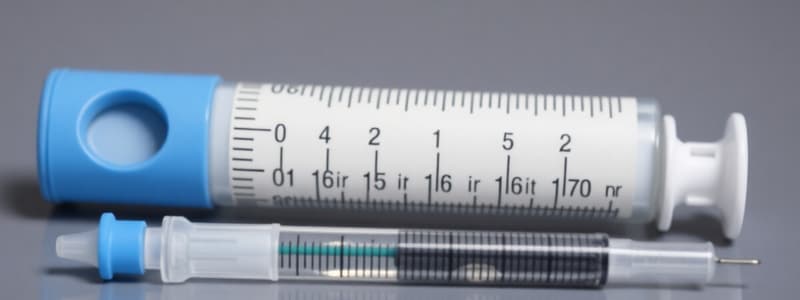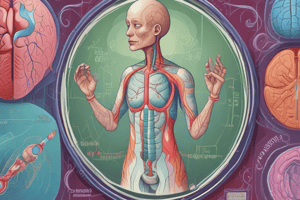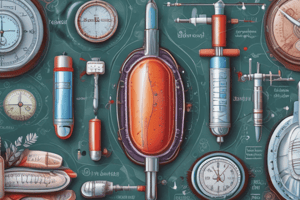Podcast
Questions and Answers
Which cells in the pancreas secrete glucagon?
Which cells in the pancreas secrete glucagon?
- Gamma cells
- Alpha cells (correct)
- Beta cells
- Delta cells
What is the role of GLP-1 in glucose regulation?
What is the role of GLP-1 in glucose regulation?
- Inhibits insulin secretion
- Stimulates alpha cells to release glucagon
- Stimulates beta cells to secrete more insulin (correct)
- Promotes glucagon release
What is a common adverse effect of insulin therapy?
What is a common adverse effect of insulin therapy?
- Hypertension
- Hypoglycemia (correct)
- Hyperglycemia
- Hypokalemia
What is the onset time for rapid-acting insulin like Apidra® or Humalog®?
What is the onset time for rapid-acting insulin like Apidra® or Humalog®?
Which insulin type has the longest duration of action?
Which insulin type has the longest duration of action?
What is the function of insulin in the body?
What is the function of insulin in the body?
Which route of administration is NOT typically used for insulin?
Which route of administration is NOT typically used for insulin?
What is a potential adverse effect of repeated insulin injections at the same site?
What is a potential adverse effect of repeated insulin injections at the same site?
Which insulin type is considered intermediate-acting?
Which insulin type is considered intermediate-acting?
Which area of the body provides the most rapid absorption of insulin?
Which area of the body provides the most rapid absorption of insulin?
Which type of insulin is recommended for continuous intravenous infusion in patients with severe hyperglycemia?
Which type of insulin is recommended for continuous intravenous infusion in patients with severe hyperglycemia?
Which insulin preparation should be gently rolled between the hands before administration?
Which insulin preparation should be gently rolled between the hands before administration?
Which long-acting insulin has the longest duration of action, lasting up to 42 hours?
Which long-acting insulin has the longest duration of action, lasting up to 42 hours?
What is the recommended starting dose for basal insulin therapy in type 2 diabetes?
What is the recommended starting dose for basal insulin therapy in type 2 diabetes?
Which combination insulin product contains 70% NPH and 30% regular insulin?
Which combination insulin product contains 70% NPH and 30% regular insulin?
Which insulin product is inhaled?
Which insulin product is inhaled?
Which type of insulin therapy is considered basal insulin therapy?
Which type of insulin therapy is considered basal insulin therapy?
Which hormone is released by the pancreas in response to hypoglycemia to raise blood glucose levels?
Which hormone is released by the pancreas in response to hypoglycemia to raise blood glucose levels?
What is the primary role of GLP-1 agonists in the management of type 2 diabetes?
What is the primary role of GLP-1 agonists in the management of type 2 diabetes?
What is a significant cardiovascular benefit of GLP-1 agonists?
What is a significant cardiovascular benefit of GLP-1 agonists?
Which GLP-1 agonist is derived from gila monster lizard saliva?
Which GLP-1 agonist is derived from gila monster lizard saliva?
Which GLP-1 agonist is available in both injectable and oral forms?
Which GLP-1 agonist is available in both injectable and oral forms?
What is a common side effect associated with GLP-1 agonists?
What is a common side effect associated with GLP-1 agonists?
What is the primary contraindication for GLP-1 agonist therapy?
What is the primary contraindication for GLP-1 agonist therapy?
What is the boxed warning associated with GLP-1 agonists?
What is the boxed warning associated with GLP-1 agonists?
Which GLP-1 agonist is associated with cardiovascular risk reduction in patients with established cardiovascular disease?
Which GLP-1 agonist is associated with cardiovascular risk reduction in patients with established cardiovascular disease?
What is the primary mechanism of action of pramlintide (Symlin®)?
What is the primary mechanism of action of pramlintide (Symlin®)?
What is a key safety concern with pramlintide (Symlin®) therapy?
What is a key safety concern with pramlintide (Symlin®) therapy?
Which GLP-1 agonist has dual action as both a GLP-1 receptor agonist and a GIP receptor agonist?
Which GLP-1 agonist has dual action as both a GLP-1 receptor agonist and a GIP receptor agonist?
What is the typical dosing schedule for long-acting insulin such as insulin glargine?
What is the typical dosing schedule for long-acting insulin such as insulin glargine?
Which insulin product should not be mixed with other insulin products due to risk of inactivation?
Which insulin product should not be mixed with other insulin products due to risk of inactivation?
What is the effect of insulin on adipose tissue?
What is the effect of insulin on adipose tissue?
What is the onset time for regular insulin when administered subcutaneously?
What is the onset time for regular insulin when administered subcutaneously?
Which insulin type is recommended for use in insulin pumps?
Which insulin type is recommended for use in insulin pumps?
Which insulin product has a milky appearance and must be rolled before administration?
Which insulin product has a milky appearance and must be rolled before administration?
What is the primary benefit of using combination insulin products?
What is the primary benefit of using combination insulin products?
Which medication can be used as an alternative to mealtime insulin in patients with type 2 diabetes?
Which medication can be used as an alternative to mealtime insulin in patients with type 2 diabetes?
What is the typical duration of action for rapid-acting insulin?
What is the typical duration of action for rapid-acting insulin?
What is a key benefit of continuous subcutaneous insulin infusion (CSII) devices?
What is a key benefit of continuous subcutaneous insulin infusion (CSII) devices?
Which insulin type is most commonly used in insulin pumps?
Which insulin type is most commonly used in insulin pumps?
Which GLP-1 agonist is associated with the greatest reduction in weight?
Which GLP-1 agonist is associated with the greatest reduction in weight?
What is the maximum daily dose for insulin glargine pens?
What is the maximum daily dose for insulin glargine pens?
Which GLP-1 agonist has a once-weekly dosing schedule?
Which GLP-1 agonist has a once-weekly dosing schedule?
Which of the following insulin products can be used intravenously?
Which of the following insulin products can be used intravenously?
What is the benefit of using inhaled insulin (Afrezza®) in patients with diabetes?
What is the benefit of using inhaled insulin (Afrezza®) in patients with diabetes?
What is the role of pramlintide (Symlin®) in diabetes management?
What is the role of pramlintide (Symlin®) in diabetes management?
What is the most significant adverse effect of insulin therapy?
What is the most significant adverse effect of insulin therapy?
Which hormone released by the pancreas acts to raise blood glucose levels?
Which hormone released by the pancreas acts to raise blood glucose levels?
What is a contraindication for inhaled insulin (Afrezza®)?
What is a contraindication for inhaled insulin (Afrezza®)?
What is the duration of action for NPH insulin?
What is the duration of action for NPH insulin?
Which GLP-1 agonist has the additional benefit of reducing cardiovascular events in patients with type 2 diabetes?
Which GLP-1 agonist has the additional benefit of reducing cardiovascular events in patients with type 2 diabetes?
Which of the following is an indication for insulin therapy?
Which of the following is an indication for insulin therapy?
What is the typical onset time for long-acting insulin such as insulin glargine?
What is the typical onset time for long-acting insulin such as insulin glargine?
What is the benefit of combining insulin with GLP-1 agonists?
What is the benefit of combining insulin with GLP-1 agonists?
Which hormone slows gastric emptying and promotes satiety?
Which hormone slows gastric emptying and promotes satiety?
Which of the following is a contraindication for GLP-1 agonists?
Which of the following is a contraindication for GLP-1 agonists?
Flashcards are hidden until you start studying
Study Notes
Pancreas and Hormones
- Alpha cells in the pancreas secrete glucagon, which raises blood glucose levels.
- GLP-1 (Glucagon-like peptide-1) stimulates beta cells to secrete more insulin, aiding in glucose regulation.
Insulin Therapy
- A common adverse effect of insulin therapy is hypoglycemia, characterized by dangerously low blood sugar levels.
- Rapid-acting insulin, such as Apidra® or Humalog®, has an onset time of 10-30 minutes.
- Insulin glargine is the insulin type with the longest duration of action.
- The function of insulin includes increasing glucose storage as glycogen in the liver.
Insulin Administration
- Insulin is typically administered subcutaneously; intramuscular administration is not standard practice.
- Repeated injections at the same site can cause lipohypertrophy, a thickening of the skin.
- NPH insulin is classified as intermediate-acting insulin, whereas the abdomen is the site with the most rapid insulin absorption.
Specific Insulin Preparations
- Regular insulin is preferred for continuous intravenous infusion during severe hyperglycemia.
- NPH insulin should be gently rolled between hands before administration.
- Tresiba® (insulin degludec) is a long-acting insulin with a duration of action up to 42 hours.
- Novolin 70/30 is a combination insulin product containing 70% NPH and 30% regular insulin.
- Afrezza® is an inhaled insulin product.
Diabetes Management
- Long-acting insulin is considered basal insulin therapy, essential for stabilizing blood glucose levels.
- Glucagon, released by the pancreas, raises blood glucose levels in response to hypoglycemia.
- GLP-1 agonists primarily increase insulin secretion, while also reducing hepatic glucose production.
Cardiovascular Benefits and Risks
- GLP-1 agonists provide cardiovascular benefits, including a decrease in blood pressure.
- Exenatide (Byetta®) is derived from the saliva of the gila monster lizard, making it unique among GLP-1 agonists.
- Semaglutide is notable for being available in both injectable and oral forms.
- A common side effect of GLP-1 agonists is weight loss.
Contraindications and Warnings
- Primary contraindication for GLP-1 agonist therapy is a history of pancreatitis, which poses serious health risks.
- GLP-1 agonists carry a boxed warning for the risk of thyroid cell tumors.
- Liraglutide has been associated with cardiovascular risk reduction in patients with established cardiovascular disease.
Pramlintide (Symlin®)
- Pramlintide's primary mechanism of action is to slow gastric emptying, which aids in regulating blood glucose levels.
- Severe hypoglycemia is a key safety concern associated with pramlintide therapy.
GLP-1 Agonists
- Tirzepatide (Mounjaro®) acts as both a GLP-1 receptor agonist and a GIP receptor agonist.
- Semaglutide is the GLP-1 agonist associated with the greatest weight reduction.
- Dulaglutide has a once-weekly dosing schedule.
Insulin Types and Administration
- Insulin glargine is a long-acting insulin typically dosed once daily and cannot be mixed with other insulin products.
- Regular insulin has an onset time of 30-60 minutes when administered subcutaneously and can be used intravenously.
- Insulin aspart is the preferred insulin type for insulin pumps.
- NPH insulin appears milky and must be rolled before administration; its duration of action is 12-24 hours.
Insulin Effects and Benefits
- Insulin enhances triglyceride storage in adipose tissue.
- Continuous subcutaneous insulin infusion (CSII) devices offer flexibility in scheduling and reduce the need for multiple injections.
- Combining insulin with GLP-1 agonists can lead to a reduced insulin dose.
Insulin for Diabetes Management
- Mealtime insulin alternatives in type 2 diabetes include GLP-1 agonists.
- The typical duration of action for rapid-acting insulin is 3-5 hours.
- A key adverse effect of insulin therapy is hypoglycemia.
Miscellaneous Medications
- Pramlintide (Symlin®) slows gastric emptying, which aids in glucose management.
- Inhaled insulin (Afrezza®) provides the advantage of avoiding injections but is contraindicated in patients with asthma.
Contraindications and Hormonal Effects
- Gastroparesis is a contraindication for GLP-1 agonists, while asthma is a contraindication for inhaled insulin.
- Glucagon is the hormone that raises blood glucose levels, while GLP-1 increases satiety and slows gastric emptying.
Insulin Therapy Indications
- Insulin therapy is indicated primarily for type 1 diabetes management.
Studying That Suits You
Use AI to generate personalized quizzes and flashcards to suit your learning preferences.



